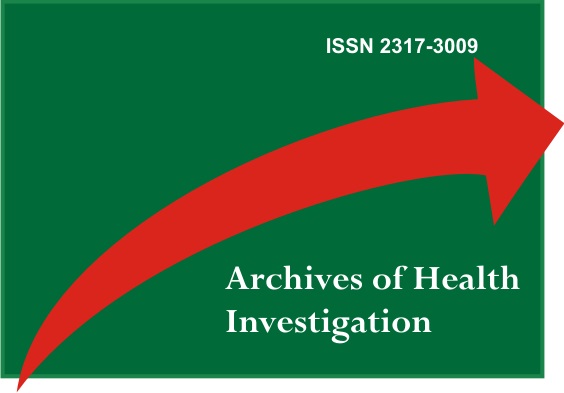Nevos Melanocíticos Adquiridos: uma Série de 4 Casos
DOI:
https://doi.org/10.21270/archi.v11i5.5898Palavras-chave:
Nevo, Nevo Pigmentado, Suturas, Nevo Intradérmico, MelanomaResumo
Introdução: Os nevos melanocíticos adquiridos cutâneos são lesões comuns, começam a aparecer na infância, aumentando em número até a meia-idade, quando sua incidência tende a diminuir. Apresentam-se como pequenas manchas, pápulas ou nódulos, geralmente menores que 6 mm com pigmentação uniforme e bordas lisas, encontradas em locais expostos ao sol. Histopatologicamente, são classificados em nevos juncional, intradérmico ou intramucoso e composto. Objetivo: mostrar uma série de 4 casos clínicos, sendo três nevos melanocíticos intradérmicos e um nevo melanocítico composto, que afetaram três pacientes do sexo feminino e um do sexo masculino, esses buscaram atendimento visando a estética. Material e método: realizado o exame clínico, nos diferentes pacientes, optou-se por remoção cirúrgica completa das lesões, que foram submetidas a avaliação histopatológica para confirmação do diagnóstico clínico. Discussão: a maioria dos pacientes que remove nevos tem como queixa a estética. No entanto, deve ser levado em consideração se a presença destes é prejudicial à função ou se apresenta características de malignidade. Ao planejar a remoção de um nevo, deve-se avaliar as linhas de expressão do paciente, para um bom resultado estético pós-cirúrgico, considerando o tipo de excisão, sutura e cuidados pós-operatórios. Conclusão: Obtivemos resultados similares aos encontrados na literatura, sendo o melhor termo estético desta série de casos a associação da incisão em meia-lua, variação do formato elíptico, com a sutura intradérmica.
Downloads
Referências
Regezi JA, Ciubba JJ, Morgan RK. Patologia bucal: correlações clinicopatológicas. 5ª ed. Rio de Janeiro: Elsevier; 2008.
Kennedy C, Bajdik CD, Willemze R, De Gruijl FR, Bouwes Bavinck JN; Leiden Skin Cancer Study. The influence of painful sunburns and lifetime sun exposure on the risk of actinic keratoses, seborrheic warts, melanocytic nevi, atypical nevi, and skin cancer. J Invest Dermatol. 2003;120(6):1087-93.
Neville BW, Allen CM, Damm DD, Allen CM, Jerry E. Patologia: Oral & Maxilofacial. 3ª. ed. Rio de Janeiro: Elsevier; 2009.
Bauer J, Garbe C. Acquired melanocytic nevi as risk factor for melanoma development. A comprehensive review of epidemiological data. Pigment Cell Res. 2003;16(3):297-306.
LeLeux TM. Pathology of Benign Melanocytic Nevi. Medscap; sep 2015.
Sampaio S, Rivitti E. Dermatologia, 3. ed. São Paulo:Artes Médicas; 2008.
Suzuki H, Anderson RR. Treatment of melanocytic nevi. Dermatol Ther. 2005; 18(3):217-26.
Commander SJ, Chamata E, Cox J, Dickey RM, Lee EI. Update on Postsurgical Scar Management. Semin Plast Surg. 2016;30(3):122-28.
Associação Brasileira de Cirurgias Plásticas. Colto P. O Brasil ultrapassou os Estados Unidos e se tornou o país que mais realiza cirurgias plásticas no mundo. [acessado 2021 mar 24]
Haas CF, Champion A, Secor D. Motivating factors for seeking cosmetic surgery: a synthesis of the literature. Plast Surg Nurs. 2008;28(4):177-82.
Lemperle G, Tenenhaus M, Knapp D, Lemperle SM. The direction of optimal skin incisions derived from striae distensae. Plast Reconstr Surg. 2014;134(6):1424-34.
Sobanko JF, Taglienti AJ, Wilson AJ, Sarwer DB, Margolis DJ, Dai J, Percec I. Motivations for seeking minimally invasive cosmetic procedures in an academic outpatient setting. Aesthet Surg J. 2015;35(8):1014-20.
Murphy K, Goodall W, Patterson A. Langer's Lines – What are they and do they matter? Br J Oral Maxillofac Surg. 2017; 55(10):e86-7.
Martín JM, Monteagudo C, Bella R, Reig I, Jordá E. Complete regression of a melanocytic nevus under intense pulsed light therapy for axillary hair removal in a cosmetic center. Dermatology. 2012;224(3):193-97.
Baigrie D, Qafiti FN, Buicko JL. Electrosurgery. 2022 May 23. In: StatPearls [Internet]. Treasure Island (FL): StatPearls Publishing; 2022 Jan–
Boroujeni NH, Handjani F. Cryotherapy versus CO2 laser in the treatment of plantar warts: a randomized controlled trial. Dermatol Pract Concept. 2018;8(3):168-73.
Angermair J, Dettmar P, Linsenmann R, Nolte D. Laser therapy of a dermal nevus in the esthetic zone of the nasal tip: A case report and comprehensive literature review. J Cosmet Laser Ther. 2015;17(6):296-300.
Boroujeni NH, Handjani F. Cryotherapy versus CO2 laser in the treatment of plantar warts: a randomized controlled trial. Dermatol Pract Concept. 2018;8(3):168-73.
Niamtu J 3rd. Esthetic removal of head and neck nevi and lesions with 4.0-MHz radio-wave surgery: a 30-year experience. J Oral Maxillofac Surg. 2014 Jun;72(6):1139-50.
Reddy Bandral M, Gir PJ, Japatti SR, Bhatsange AG, Siddegowda CY, Hammannavar R. A Comparative Evaluation of Surgical, Electrosurgery and Diode Laser in the Management of Maxillofacial Nevus. J Maxillofac Oral Surg. 2018;17(4):547-56.
Busam KJ. Melanocytic Proliferations. In: Busam KJ, ed. Dermatopathology. Saunders Elsevier, Philadelphia, PA, 2010:437-98.
Zuber TJ. Fusiform excision. Am Fam Physician. 2003;67(7):1539-44, 1547-8, 1550.
Goldberg LH, Alam M. Elliptical excisions: variations and the eccentric parallelogram. Arch Dermatol. 2004;140(2):176-80.
Alvarado A. Designing Flaps for Closure of Circular and Semicircular Skin Defects. Plast Reconstr Surg Glob Open. 2016;4(1):e607.
Stoecker A, Blattner CM, Howerter S, Fancher W, Young J, Lear W. Effect of Simple Interrupted Suture Spacing on Aesthetic and Functional Outcomes of Skin Closures. J Cutan Med Surg. 2019 Nov/Dec;23(6):580-85.
Gomes OM, Amaral AS, Gonçalves AJ, Brito AS, Monteiro EL. New suture techniques for best esthetic skin healing. Acta Cir Bras. 2012;27(7):505-8.


